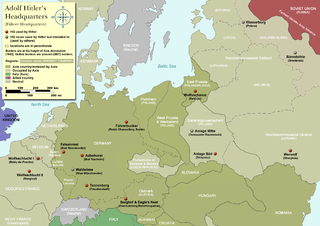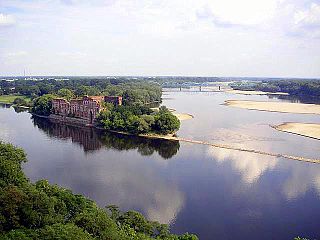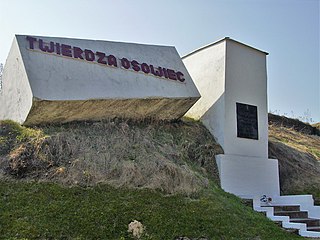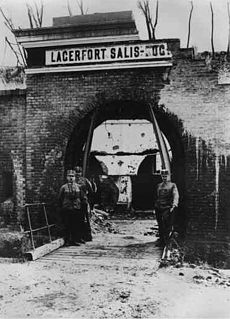 W
WBoyen Fortress is a former Prussian fortress located in the western part of Giżycko, in Warmian-Masurian Voivodeship, northeastern Poland. It is situated on a narrow isthmus between two large lakes of the Masurian Lake District, Kisajno and Niegocin.
 W
WDęblin Fortress refers to the 19th century fortifications in the town of Dęblin, Poland. The fortifications were constructed from 1830s by the Russian Empire.
 W
WThe Führer Headquarters, abbreviated FHQ, were a number of official headquarters used by the Nazi leader Adolf Hitler and various other German commanders and officials throughout Europe during the Second World War. The last one used, the Führerbunker in Berlin, where Hitler committed suicide on 30 April 1945, is the most widely known headquarters.
 W
WKłodzko Fortress is a unique fortification complex of the Lower Silesian Voivodeship in southwestern Poland. The fortress once was one of the biggest strongholds in Prussian Silesia, however, in the whole German Empire, it was regarded as a minor one. Now, together with an extensive network of tunnels, it is one of the biggest attractions of the town of Kłodzko, with its underground labyrinth and a repository of different objects, from old fire engines to local glassware.
 W
WThe Festungsfront Oder-Warthe-Bogen, also called the Festung im Oder-Warthe-Bogen or Ostwall, and in Polish the Międzyrzecki Rejon Umocniony, MRU, was a fortified military defence line of Nazi Germany between the Oder and Warta rivers, near Międzyrzecz. The part around Międzyrzecz (Meseritz) has been colloquially referred to as the Regenwurmlager. Built in 1934–44, it was the most technologically advanced fortification system of Nazi Germany, and remains one of the largest and the most interesting systems of this type in the world today. It consists of around 100 concrete defence structures partially interconnected by a network of tunnels. Some of the forts and tunnels are available for visiting.
 W
WModlin Fortress is one of the largest 19th-century fortresses in Poland. It is located in the town of Nowy Dwór Mazowiecki in district Modlin on the Narew river, approximately 50 kilometers north of Warsaw. It was originally constructed by the French from 1806 to 1812.
 W
WOsowiec Fortress is a 19th-century fortress located in north-eastern Poland, built by the Russian Empire. It saw heavy fighting during World War I when it was defended for several months by its Russian garrison against German attacks.
 W
WPrzemyśl fortress was a series of fortifications constructed at Przemyśl by the Austro-Hungarian Empire from the mid 19th century until the First World War. It was constructed in sections, depending on the diplomatic relations between Austria and the Russian Empire, and saw extensive combat during World War I. Originally captured by the Russian Army, it was recaptured by the German Army in mid-1915. Afterwards the ruined fortifications lost their military significance.
 W
WFort Srebrna Góra or Srebrnogórska Fortress is a former military fort, now a monument and a museum, located in the town of Srebrna Góra, Lower Silesian Voivodeship, Poland. It was constructed in 1765–1777 when the territory was part of the Kingdom of Prussia.
 W
WWisłoujście Fortress is an historic fortress located in Gdańsk by the Martwa Wisła river, by an old estuary of the river Vistula, flowing into the Bay of Gdańsk. The fortress is located close to the Wisłoujście borough, Westerplatte and the Port Północny.
 W
WZamość Fortress is a set of fortifications constructed together with the city of Zamość. It was built between 1579 and 1618, and the construction was initiated by Chancellor and Hetman Jan Zamoyski. It was one of the biggest fortresses of the Polish-Lithuanian Commonwealth, built so solidly that it was able to resist the attacks of both the Cossacks and the Swedes during the Deluge. It was taken down in 1866, although fragments survive.
 W
WThe Zegrze Fortress is a military structure located in Zegrze, Poland, on a high escarpment over the Narew River. Built in late 19th century by the Russian Empire, it was to guard a river crossing across the Narew. Modernised between 1902 and 1907, it was part of the so-called Warsaw Fortified Area comprising three major nodes: the Warsaw Fortress, Modlin Fortress and Zegrze.